Catholic Church
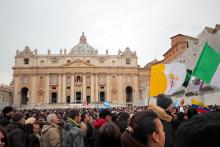
Editor's Note: Pope Francis delivered the following homily at his inaugural Mass on Tuesday, emphasizing the need to protect the poor and the environment.
Dear Brothers and Sisters,
I thank the Lord that I can celebrate this Holy Mass for the inauguration of my Petrine ministry on the solemnity of Saint Joseph, the spouse of the Virgin Mary and the patron of the universal Church. It is a significant coincidence, and it is also the name-day of my venerable predecessor: we are close to him with our prayers, full of affection and gratitude.
I offer a warm greeting to my brother cardinals and bishops, the priests, deacons, men and women religious, and all the lay faithful. I thank the representatives of the other Churches and ecclesial Communities, as well as the representatives of the Jewish community and the other religious communities, for their presence. My cordial greetings go to the Heads of State and Government, the members of the official Delegations from many countries throughout the world, and the Diplomatic Corps.
In the Gospel we heard that "Joseph did as the angel of the Lord commanded him and took Mary as his wife" (Mt 1:24). These words already point to the mission which God entrusts to Joseph: he is to be the custos, the protector. The protector of whom? Of Mary and Jesus; but this protection is then extended to the Church, as Blessed John Paul II pointed out: "Just as Saint Joseph took loving care of Mary and gladly dedicated himself to Jesus Christ’s upbringing, he likewise watches over and protects Christ’s Mystical Body, the Church, of which the Virgin Mary is the exemplar and model" (Redemptoris Custos, 1).
How does Joseph exercise his role as protector? Discreetly, humbly and silently, but with an unfailing presence and utter fidelity, even when he finds it hard to understand. From the time of his betrothal to Mary until the finding of the twelve-year-old Jesus in the Temple of Jerusalem, he is there at every moment with loving care. As the spouse of Mary, he is at her side in good times and bad, on the journey to Bethlehem for the census and in the anxious and joyful hours when she gave birth; amid the drama of the flight into Egypt and during the frantic search for their child in the Temple; and later in the day-to-day life of the home of Nazareth, in the workshop where he taught his trade to Jesus.
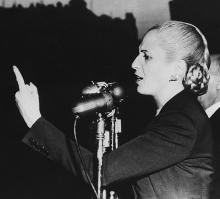
In 1974, when the Rev. Jorge Bergoglio was the top Jesuit in his native Argentina, a former nightclub dancer named Isabel Peron came to head the nation – an accidental and weak president.
Isabel Peron served less than two years in office before a right-wing military coup placed her under house arrest, and launched a seven-year campaign of torture and killings of tens of thousands of trade unionists and other leftists: Argentina’s Dirty War.
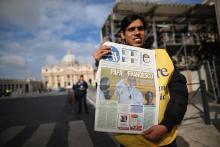
When I heard about the white smoke on Wednesday, I wrote on my Facebook wall: “Habent Papum.” My own church doesn’t use Latin, so I had to use Google translate to figure out how to change the “We have a pope” of “Habemus Papam” into “They have a pope.” I got a few good laughs for my cleverness before a Catholic friend humbly reminded me that it wasn’t just their pope, and that I’d have to deal with him too ... he has no idea how prophetic his words have turned out to be.
You see, I didn’t expect to tune in at all to the election of the pope. I was raised in the Catholic Church and received its early sacraments before my family joined the Episcopal Church (my father’s tradition). I spent plenty of time in high school and after defending its practices and traditions against atheists and Protestant friends and colleagues, and I more than made up for that by pressing hard on my Catholic friends on the nuances I didn’t understand. But mostly I only paid attention when the Catholic Church said something publicly or took a political stand on an issue I cared about.
But on Wednesday, the white smoke got in my eyes, and rather than confusing my sight, it’s made things a little clearer.
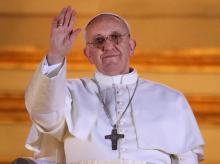
Francis. Pope Francis. This could be good news for the Catholic Church, for the whole church, and for the world. Let’s hope and pray so.
Jorge Bergoglio, the Argentinian cardinal from Buenos Aires, will be the first pope from Latin America and the first outside of Europe in a millennium. That’s good news from the start. And the world is now learning about the 76-year-old new pontiff whose election caused the white smoke to rise in the night skies of Rome to the cheers of tens of thousands of people in St. Peter’s Square. A Jesuit scholar, he seems to be a humble man who lives simply, choosing to live in a small apartment instead of the archbishop’s palace, and travel on buses and trams instead of in the church limousine.
Will simplicity and social justice become the witness of the Roman Catholic Church around the world — and will it emanate from the first pope from the Global South, which is clearly the growing future of the church? What good news that would be.
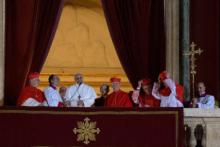
VATICAN CITY — A hierarchy looking to make a clear statement about where the troubled church is headed chose on Wednesday the first member of the influential Jesuit order to be the next pope. Yet they also chose Cardinal Jorge Mario Bergoglio, a humble man who lives simply and took the name Francis (also a first) that evokes the founder of another great religious order.
The College of Cardinals picked the first non-European in modern times, as well – yet he is the son of Italian immigrants and grew up in Argentina, perhaps the most European of any country in Latin America.
And the cardinals above all wanted a pastoral figure who would project an image of vigor and warmth to the world after the eight-year reign of Pope Benedict XVI — an introverted, gaffe-prone German theologian who was 78 when he was elected and retired last month at 85, saddled by the burdens of this very public office.
Yet in his stead they chose a soft-spoken a 76-year-old who has been rapped for rarely cracking a smile — an image that Bergoglio did little to dispel with his low-key introduction as Pope Francis to the expectant crowd in St. Peter’s Square on a rainy Roman evening.
“Buona sera,” Francis said in deliberate, word perfect Italian, with just a slight Spanish accent. “You all know that the duty of the conclave was to give a bishop to Rome. It seems that my brother cardinals have come almost to the ends of the earth to get him … but here we are.”
So what, in fact, does the election of Francis say about the Catholic Church at this point in its history?
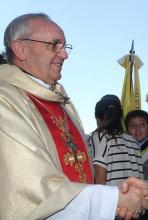
Argentinian Cardinal Jorge Mario Bergoglio was elected as Pope Francis I on Wednesday, after only two days of voting in the conclave tasked with choosing a successor to Pope Benedict XVI.
According to anonymous reports of the 2005 conclave, he was the leading contender against then-Cardinal Joseph Ratzinger, who became Benedict XVI. Bergoglio, 76, has served as the archbishop of Buenos Aires since 1998 and was made a cardinal in 2001. He is the first Latin American and the first Jesuit to rise to the papacy.
In his first address to the huge crowd that had gathered in St Peter’s Square, Francis asked for the prayers of “all men and women of good will” to help him lead the Catholic Church.
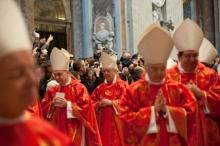
VATICAN CITY — As 115 cardinal-electors solemnly processed into the Sistine Chapel on Tuesday afternoon, with a cry of “Extra omnes!” and the latest high-tech jamming devices cutting them off from the world, the buzz outside the Vatican over who would eventually emerge as pope grew deafening.
Everyone had theories, many had favorites, and most declared it all so unpredictable that the winner – or even how long it would take to find him – was anybody’s guess.
“We are living through an extraordinary conclave,” Marco Tosatti wrote in La Stampa, the Italian daily whose insider coverage of the pre-conclave meetings read like a tip sheet for papal bookies.
“If we look at the history of conclaves over the last century, never has there been such a range of choices, and such uncertainty over the outcome up to the moment that the doors of the Sistine Chapel closed,” he said.
In fact, the latest lines were varied and morphing all the time, a feast of permutations for Vaticanisti who parse papal elections the way sci-fi geeks deconstruct a new installment of “Star Wars.”
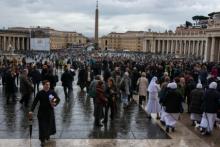
VATICAN CITY — Black smoke from the chimney atop the Sistine Chapel signaled that the first day of the conclave ended without the election of a new pope.
Even if the first-round outcome was largely expected, thousands of people on Tuesday braved the inclement Roman weather to wait for the result of the vote. They slowly filled up St. Peter’s Square as the evening progressed, with their eyes fixed on the small chimney.
Cries of disappointment erupted from the crowd when the black smoke appeared instead of the white smoke that would herald a successful election.
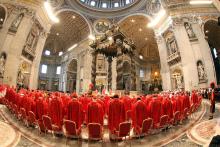
VATICAN CITY — The doors of the Sistine Chapel closed behind the cardinals on Tuesday, marking the official start of the conclave that will elect the successor to Pope Benedict XVI.
The 115 cardinal-electors walked in procession into the Sistine Chapel, singing hymns and invoking the Holy Spirit, before filing under Michelangelo’s “Last Judgment” and taking a solemn oath of secrecy on everything that will happen during the conclave.
At the end of the oath-taking ceremony, the master of papal ceremonies, the Rev. Guido Marini, ordered the “extra omnes” (Latin for “everybody out”).
Cardinals will be sequestered inside a Vatican residence until a candidate receives the two-thirds majority needed for election to the papacy.
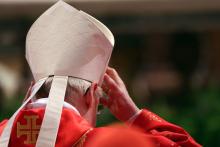
As the College of Cardinals begins its conclave today in Rome to select the next Pope, I find myself intensely interested in the outcome. Since I am an Anabaptist, a child of the “radical” Reformation, I’ve spent some time reflecting on why that is so.
First, the Roman Catholic Church is an unbroken link to the first century Roman church for all Christians, no matter our denomination. Before the so-called “Great Schism” between the eastern and western church in 1054, the Christian church led from Rome was THE primary Christian church. No matter if we are Eastern or Western Christians, no matter how Protestant or Anabaptist some of us are, the Church of Rome is still in some way our Mother church.
Second, it remains the largest Christian tradition in the world.
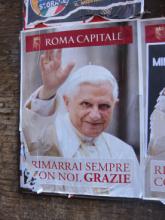
VATICAN CITY — Amid all of the prognosticating about who the cardinals could choose as the next pope in the conclave that starts here on Tuesday, one reliable thread has emerged: the desire to elect a pontiff who can be a pastor to the world as well as a taskmaster to the Roman Curia.
Finding such a combination in a single man, of course, may prove difficult if not impossible, which adds to the almost unprecedented level of uncertainty surrounding this papal election.
So if anything is possible, some say it might be better to reverse the prevailing wisdom — look for a pope who will talk tough to Catholics (and the world) while shepherding the Curia with a firm hand in order to better police the wayward.
The prospect might appall progressives and others who were happy to see the end of Pope Benedict XVI’s papacy, but it has enough appeal to conservatives that they are trying to make the case.
One reason for their sense of urgency is that Cardinal Joseph Ratzinger turned out to be more of a papal pussycat as Benedict XVI than the watchdog of orthodoxy that he had been for decades while serving under John Paul II.
Is now the time for a pope who could be more of a Ratzinger than a Benedict?
VATICAN CITY — The conclave to pick a new pope will begin on Tuesday the Vatican said on Friday, resolving an open question that had dogged the cardinals meeting here over the past week.
The cardinals will celebrate a special Mass “pro eligendo Romano Pontifice” — for the election of the Roman Pontiff — in St. Peter’s Basilica on Tuesday morning, and in the afternoon the cardinals will enter into the Conclave, the Vatican said.
The date was set by the cardinals gathered in a late-afternoon session on Friday. They were scheduled to vote on the decision, but there was no word on how many supported the Tuesday start date or how many preferred an earlier or a later date.
In one of his last acts before resigning on Feb. 28, Pope Benedict XVI amended the law regulating papal elections to allow cardinals to move up the beginning of the conclave, which would normally not be able to start until at least 15 days after a pope dies or leaves office.
Because Benedict resigned — the first pope to do so in 600 years — and announced his plans on Feb. 11, the cardinals did not have to focus on a funeral, as they did when John Paul II died in April 2005. They also have had nearly a month to think about a successor.
As a result, many believed the cardinals did not need to wait long after Benedict’s resignation took effect to begin the conclave itself.
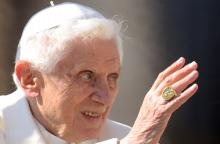
VATICAN CITY — The papacy of Benedict XVI came to a quiet end at 8 p.m. on Thursday, making him the first pope in 600 years to voluntarily leave office.
While there was no formal ceremony to mark the historic passage, the end of Benedict’s papacy and the beginning of the “sede vacante” interim period was clear when the Swiss Guards left their post at the gate of the papal summer residence in Castel Gandolfo.
The Swiss Guards are charged with protecting the pope. When Benedict ceased to be pope, his security was no longer in their hands. At the Vatican, officials sealed the pope’s apartment as prescribed by church law, and will destroy the pope’s ring and official seal in the coming days.

The Vatican appears rocked by scandalous rumors and resignations just as church leaders must gear up to replace frail Pope Benedict XVI with a closed-door conclave.
But Vatican experts say if you think the world’s largest nongovernmental institution is in unprecedented chaos right now, think again.
Vatican Secretary of State Cardinal Angelo Sodano presents the papal fisherman ring to Pope Benedict XVI at the new pope’s installation Mass. The fisherman’s ring bears an image of Peter, his boat and his net, which figure in two Gospel accounts of miraculous catches of fish. Benedict said that while fish die when removed from the sea, “in the mission of a fisher of men the reverse is true.”
“Have you ever heard of the Borgias?” quipped professor Terrence Tilley, chairman of the theology department for Fordham University in New York. They were the larcenous, adulterous, murderous, election-rigging, Renaissance-era family of renaissance popes “who ran the papacy for decades like a private fief.”
For all the sex, money, and power headlines wafting out of Rome these days, at least no one has been murdered. Infighting and innuendo, though, are ancient traditions that have moved into the bright lights of the 24/7 news cycle and social media.
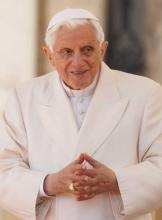
You won’t find many Catholic churches named after Pope Benedict IX.
Benedict IX squandered the papacy’s moral and financial riches in bordellos and banquet halls. His violence and debauchery “shocked even the Romans,” said philosopher Bertrand Russell, which is kind of like being busted for lewdness in Las Vegas. He was a puppet pope, installed by his powerful family at a time when rival clans ruled Rome. The young man seemed uninterested in religious life, rushing through ordination only after his election to the Throne of St. Peter in 1032.
St. Peter Damian called Benedict IX a "demon from hell in the disguise of a priest." The Catholic Encyclopedia labels him a “disgrace to the chair of St. Peter.” He was the first Pope Benedict to resign, selling the papacy for gold in order to marry. He later tried to reclaim the holy office and served three stints as pope between 1032 and 1048.
Nearly a millennium later, the pious and bookish Pope Benedict XVI seems completely contrary to his notorious namesake. Even if his papacy has stumbled at times, by all accounts the current Benedict has led a chaste life devoted to serving his church.

Life inside a bubble can feel complete, even dynamic, as the bubble’s surface shimmers and yet retains form.
When the surface is breached, the bubble collapses immediately, shattering into a liquid spray faster than a metal object can fall through where it used to be. What looked like a permanent structure is, in fact, uncertain and quickly lost.
We saw a ”tech bubble” burst 13 years ago. What had seemed durable and laden with value turned out to be vapor. The “housing bubble” came next. Some think another “tech bubble” is about to burst.
The bubble I see bursting is establishment Christianity in America. It is bursting ever so slowly, even as millions of people still find life, meaning, safety, and structure inside. But one failing congregation at a time, the surface of shimmering shape is being breached.
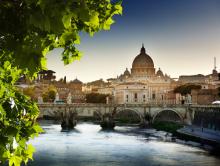
If you want a crash course on how papal politics really works, look no further than the saga of Scottish Cardinal Keith O’Brien.
On Friday, Britain’s most senior Catholic cleric grabbed headlines by telling the BBC that priestly celibacy was “not of divine origin” and that he’d be “happy” if priests had the option to marry.
On Saturday, O’Brien was back in the news, this time after four men reportedly accused him of “inappropriate acts” dating back to the 1980s.
By Monday, O’Brien had resigned as archbishop of Saint Andrews and Edinburgh and announced he would skip the conclave.
From champion of married priests to disgraced churchman within 72 hours, O’Brien’s trajectory is stunning but also emblematic of the frenetic and fever-pitched campaigning that occurs during the tiny window between a pope’s death or resignation and the election of his successor.
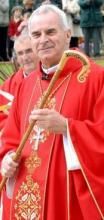
Cardinal Keith O’Brien of Scotland resigned on Monday in the wake of explosive charges that he had made “inappropriate” sexual advances to four men, three of them priests, and one now a former seminarian, starting in the 1980s.
O’Brien said he would skip next month’s conclave to elect a successor to Pope Benedict XVI, leaving the United Kingdom without a cardinal’s voice in the election of a new pope.
In a statement, O’Brien said Benedict had accepted his resignation effective immediately, and he appeared to allude to the events surrounding his sudden exit.
“Looking back over my years of ministry: For any good I have been able to do, I thank God. For any failures, I apologize to all whom I have offended,” said the cardinal, who turns 75 next month, which is the mandatory retirement age for bishops. Cardinals retain the right to vote in a conclave until age 80.
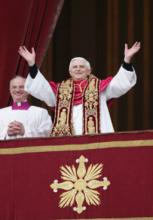
VATICAN CITY — The Vatican on Wednesday confirmed that Pope Benedict XVI is considering changes to church law regulating the election of a new pope, but stopped short of saying whether voting could start earlier than currently planned.
Pope John Paul II’s 1996 Apostolic Constitution “Universi Dominici Gregis” regulates what happens between the death or resignation of a pope and the election of his successor.
It stipulates that the conclave of cardinals must begin 15 to 20 days after the end of the previous pontificate.
But after Benedict’s surprise announcement that he will resign on Feb. 28, several voices within the church have asked for an earlier start to the voting to shorten the time the Catholic Church is left without a leader.
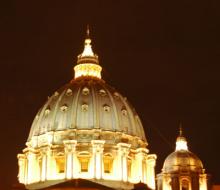
VATICAN CITY — As of 8 p.m. on Feb. 28, Pope Benedict XVI will no longer be pope and the Vatican will go into “sede vacante” mode — a Latin expression that means that the seat of St. Peter is vacant.
So who’s in charge until a new pope is chosen? The “interregnum” between two popes is governed by ancient rituals and by institutions half forgotten even within the Vatican.
But it is also the only time that the Catholic Church comes close to vaguely resembling a democracy, with the College of Cardinals acting somewhat like a Parliament with limited powers as it prepares to choose the new pontiff in a closed-doors conclave.